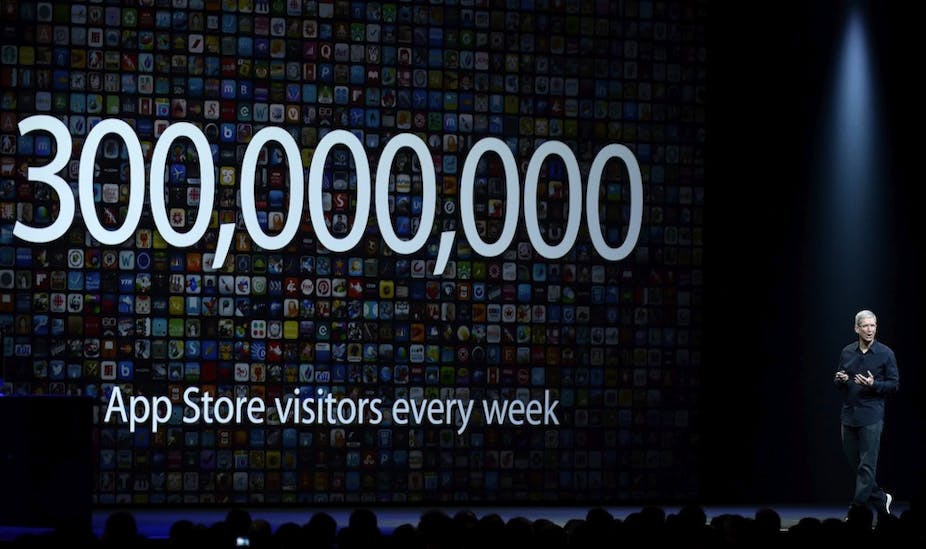Apple’s Worldwide Developers Conference is one of the two main events of the year where Apple gives pause to the rumour mill about its future plans and tells all. Well, almost all. Although Apple has launched new hardware at these events in the past, in recent years WWDC has been reserved for announcements about the key features that will be appearing in its software platforms for its mobile phones, tablets and computers.
The importance of the WWDC’s keynote event is how it serves to confirm the technologies Apple believes are important and potentially how the company will continue to generate revenue growth. But Apple has continued to disappoint both its investors and the wider public with its seeming unwillingness to be a leader in technologies, a ground being increasingly occupied by companies like Google and Samsung.
This year proved to be no different. Apple CEO Tim Cook outlined an upgrade to Mac OS X, as well as the features of its operating system iOS8 - as well as the introduction of Swift, a new programming language for apps. What these all show is that Apple has become very good at incrementally improving their products and bringing their mobile and PC platforms ever closer together.
But missing were any new hardware announcements. In fact, on this level, the keynote was more significant for what it didn’t announce than what it did, as I’ll explain a little later.
Apple Mac OS X 10.10 Yosemite
Apple’s Mac OS X gets an upgrade, with the next version to be called Yosemite. The user interface has changed to become more like iOS 7 with icons losing their 3D texture and becoming flat. Thankfully the redesign seems to have stopped short of the candy coloured theme of iOS.
The functional changes are welcome even if they are providing functionality already available in other products like Gmail and DropBox. Apple has introduced its own version of DropBox, for example, called iCloud Drive. The prices of storage on iCloud Drive may cause some concern for DropBox, but Apple has tried cloud storage before and struggled to match the feature development of others in this space. A new feature called Continuity allows tasks like writing mail to be started on a Mac and continued on an iPad and vice versa. AirDrop, a feature to share files will now work between Macs and iPhones/iPads.
iOS 8
The big announcement with iOS 8 is the introduction of support for home automation integration called HomeKit and a health data integration environment called HealthKit. These platforms are similar in concept to PassBook, Apple’s platform for handling tickets and vouchers. They rely on other companies to support the platform and use an Apple provided application to summarise the information and present it to the user. It is worth noting that the HealthKit is really aimed at the personal fitness market rather than personal health, despite the mention of a collaboration with the Mayo Clinic to incorporate blood pressure measurements. Apple will be hoping that these new platforms will achieve a greater level of engagement than PassBook did.
Apple has added a number of other tweaks to iOS. More can be done in the notification centre without opening the app. Photos are automatically backed up to iCloud and there are more search and editing functions. New for Apple is more sophisticated predictive text and the ability to integrate custom keyboard software, a feature that has been available in Android phones for some time.
Swift, a new development language
Probably the most surprising announcement was the introduction to Swift, a new programming language that aims to make development of apps on the Apple platform easier. Apple now joins Google and Microsoft in inventing its own development language. Although it will undoubtedly attract some developers, it now presents a challenge for existing developers to re-learn the language and of course the language is specific to the Apple platform.
So what wasn’t announced?
No iWatch or wearables development kit. There was no suggestion that Apple was preparing to enter the wearables market with a watch for example. Unlike Google who announced a software platform Android Wear for third party manufacturers, Apple didn’t announce anything similar.
No payment platform. Apple has steadfastly avoided supporting NFC technology in its phones that would allow banks and other companies to use this technology for mobile payments. This has been long held to be because it was developing its own payment platform but if it is, then this isn’t the year for it.
No cross-platform. One issue with the changes that Apple has introduced is that they will be irrelevant to many people who do not use Apple for their personal computing as well as for mobile. Of course, Apple wants to make using its technology throughout as attractive as possible by offering a tighter integration. There is a fine line however between providing incentives and added functionality to a platform and creating a situation where the individual parts become less than the whole.
With the continued dominance of Android globally, picking platforms and technologies that are specific to Apple will become harder and reminiscent of the decision facing developers when choosing to write software for Windows or the Mac.

